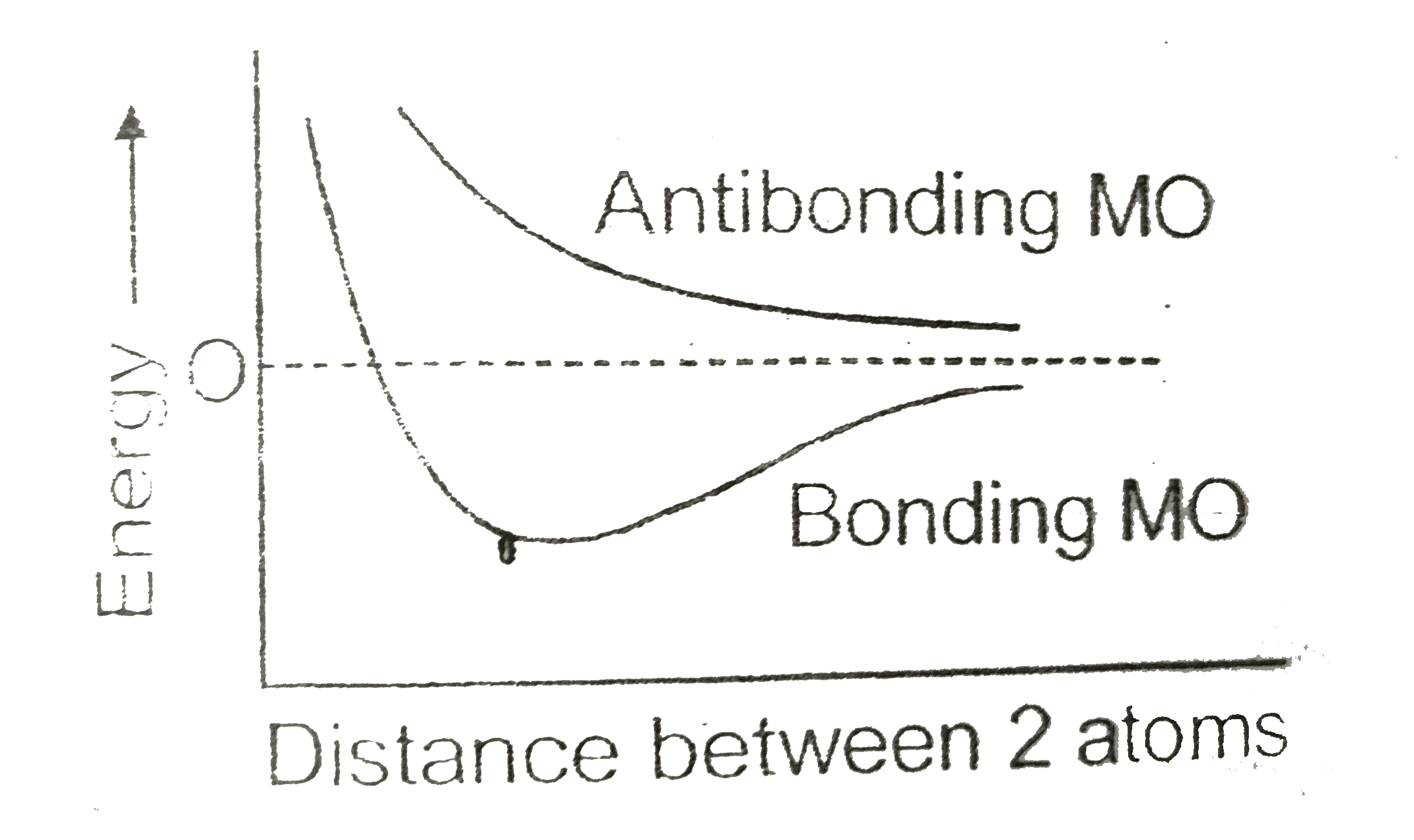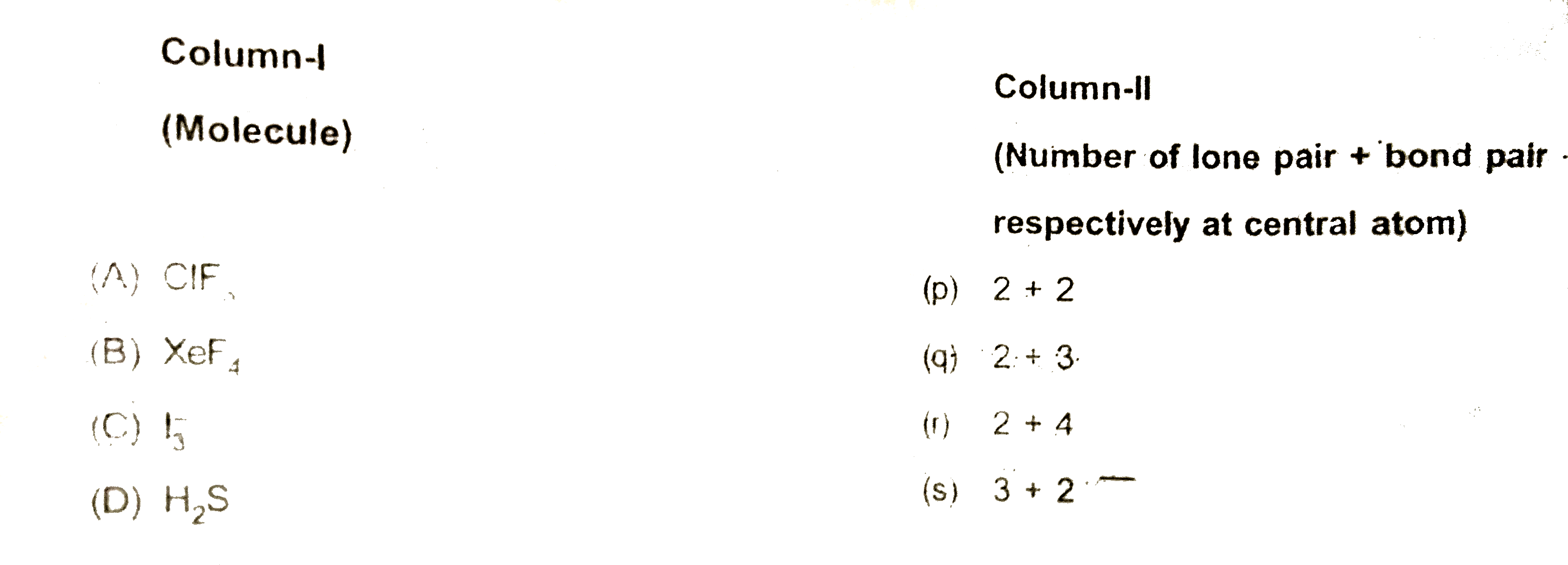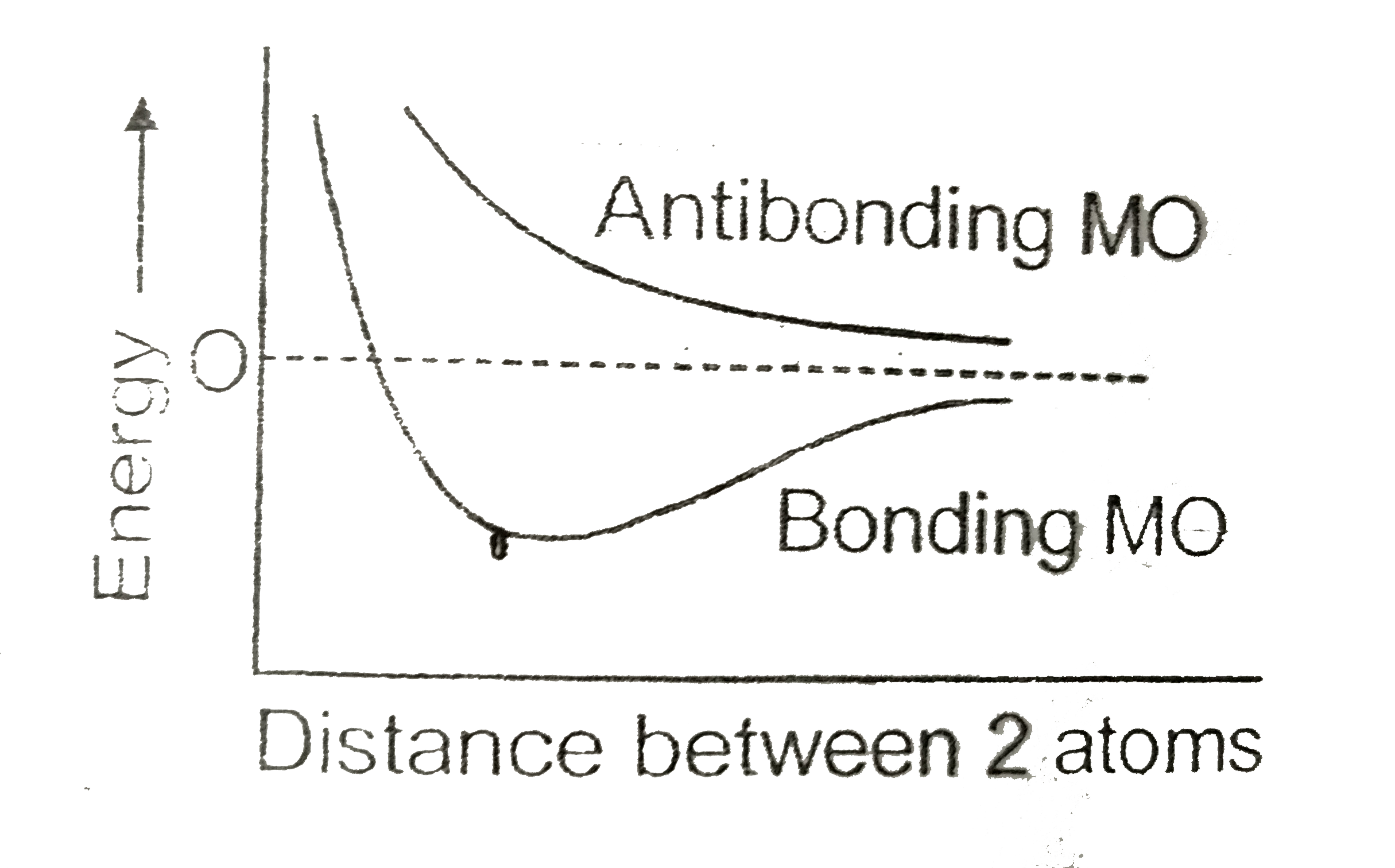Molecular orbital (MOT) the atoms in a molecule are supposed to loose their individual control over the electrons . The nuclei of the bonded atoms are considered to be present at equilibrium in inter-nuclear positions . The orbitals where the probability of finding electrons is maximum are called molecular orbitals extending over 2 or more nuclei when a pair of atomic orbitals combine and give rise to a pair of molecular MO's in internuclear region but decreased for antibonding MO's . Shielding of the nuclei by-increased electron density in bonding MO's reduces inter nuclear repulsion & thus stabilizes the molecule whereas lower electron density in antibonding MO's increases the repulsion and destabilises the system .

Which of the following is the correct order of bond strength of given species ?
N2>N+2>N−2
N2>N−2>N+2
N+2>N2>N−2
N−2>N2>N+2
The correct Answer is:A
Step by step video & image solution for Molecular orbital (MOT) the atoms in a molecule are supposed to loose their individual control over the electrons . The nuclei of the bonded atoms are considered to be present at equilibrium in inter-nuclear positions . The orbitals where the probability of finding electrons is maximum are called molecular orbitals extending over 2 or more nuclei when a pair of atomic orbitals combine and give rise to a pair of molecular MO's in internuclear region but decreased for antibonding MO's . Shielding of the nuclei by-increased electron density in bonding MO's reduces inter nuclear repulsion & thus stabilizes the molecule whereas lower electron density in antibonding MO's increases the repulsion and destabilises the system . Which of the following is the correct order of bond strength of given species ? by Chemistry experts to help you in doubts & scoring excellent marks in Class 12 exams.
Updated on:21/07/2023Topper's Solved these Questions
- CHEMICAL BONDING AND MOLECULAR STRUCTURE BOOK - AAKASH INSTITUTE ENGLISHCHAPTER - CHEMICAL BONDING AND MOLECULAR STRUCTURE EXERCISE - Assignment Section - E (Assertion-Reason Type Questions)
10 Videos
- CHEMICAL BONDING AND MOLECULAR STRUCTURE BOOK - AAKASH INSTITUTE ENGLISHCHAPTER - CHEMICAL BONDING AND MOLECULAR STRUCTURE EXERCISE - Assignment Section -F (Matrix- Match Type Questions)
4 Videos
- CHEMICAL BONDING AND MOLECULAR STRUCTURE BOOK - AAKASH INSTITUTE ENGLISHCHAPTER - CHEMICAL BONDING AND MOLECULAR STRUCTURE EXERCISE - Assignment Section - C Objective Type Questions(More than one options are correct )
13 Videos
- BIOMOLECULESBOOK - AAKASH INSTITUTE ENGLISHCHAPTER - BIOMOLECULESEXERCISE - EXERCISE (ASSIGNMENT) SECTION - D Assertion - Reason Type Questions
5 Videos
- CHEMICAL KINETICSBOOK - AAKASH INSTITUTE ENGLISHCHAPTER - CHEMICAL KINETICSEXERCISE - ASSIGNMENT (SECTION D : Assertion - Reason Type Questions)
15 Videos
Similar Questions
Statement-1 : Polarisation is the distortion of the shape of an anion by adjacently placed cation.
and
Statement-2 : Maximum polarisation is brought by a cation of high charge .
View SolutionMatch the following

View SolutionCO2 has same geometry as .
View Solution(i) What type of isomers are glucose and fructose ?
(ii) Name the functional group common to both glucose and fructose.
View SolutionA : Rate of reaction depends upon the concentration of the reactants.
R : The order of reaction can be negative with respect to substance present in the reaction.
View SolutionMolecular orbital (MOT) the atoms in a molecule are supposed to loose their individual control over the electrons . The nuclei of the bonded atoms are considered to be present at equilibrium in inter-nuclear positions . The orbitals where the probability of finding electrons is maximum are called molecular orbitals extending over 2 or more nuclei when a pair of atomic orbitals combine and give rise to a pair of molecular MO's in internuclear region but decreased for antibonding MO's . Shielding of the nuclei by-increased electron density in bonding MO's reduces inter nuclear repulsion & thus stabilizes the molecule whereas lower electron density in antibonding MO's increases the repulsion and destabilises the system . Which of the following is the correct order of bond strength of given species ?
View SolutionMolecular orbital (MOT) the atoms in a molecule are supposed to loose their individual control over the electrons . The nuclei of the bonded atoms are considered to be present at equilibrium in inter-nuclear positions . The orbitals where the probability of finding electrons is maximum are called molecular orbitals extending over 2 or more nuclei when a pair of atomic orbitals combine and give rise to a pair of molecular MO's in internuclear region but decreased for antibonding MO's . Shielding of the nuclei by-increased electron density in bonding MO's reduces inter nuclear repulsion & thus stabilizes the molecule whereas lower electron density in antibonding MO's increases the repulsion and destabilises the system .

Which of the following hetero-diatomic molecular ion is paramagnetic ?
View SolutionMolecular orbital (MOT) the atoms in a molecule are supposed to loose their individual control over the electrons . The nuclei of the bonded atoms are considered to be present at equilibrium in inter-nuclear positions . The orbitals where the probability of finding electrons is maximum are multicentred orbitals called molecular orbitals extending over 2 or more nuclei when a pair of atomic orbitals combine and give rise to a pair of molecular MO's in internuclear region but decreased for antibonding MO's . Shielding of the nuclei by-increased electron density in bonding MO's reduces inter nuclear repulsion & thus stabilizes the molecule whereas lower electron density in antibonding MO's increases the repulsion and destabilises the system . Which of the following species have identical value of bond order ?
View SolutionMolecular orbitals are formed by the overlap of atomic orbitals . Two atomic orbitals combine to form two molecular orbitals, called Bonding Molecular Orbital (BMO) and Anti - Bonding Molecular Orbital (ABMO). Different atomic orbitals of one atom combine with those atomic orbitals of the second atom which have comparable energles and proper orientation Further, if overlapping is head on, the molecular orbitals is called 'sigma' and if the overlap is lateral, the molecular orbital is called 'pi' . The molecular orbitals are filled with electrons following the same rules as followed for filling of atomic orbitals . However, the order of filling in not the same for of the most important parameter to compare a number of their characteristics Whihc one of the following statements is corrects ?
View SolutionMolecular orbitals are formed by the overlap of atomic orbitals . Two atomic orbitals combine to form two molecular orbitals, called Bonding Molecular Orbital (BMO) and Anti - Bonding Molecular Orbital (ABMO). Different atomic orbitals of one atom combine with those atomic orbitals of the second atom which have comparable energles and proper orientation Further, if overlapping is head on, the molecular orbitals is called 'sigma' and if the overlap is lateral, the molecular orbital is called 'pi' . The molecular orbitals are filled with electrons following the same rules as followed for filling of atomic orbitals . However, the order of filling in not the same for of the most important parameter to compare a number of their characteristics Which one of the following has maximum number of nodal planes ?
View SolutionMolecular orbitals are formed by the overlap of atomic orbitals . Two atomic orbitals combine to form two molecular orbitals, called Bonding Molecular Orbital (BMO) and Anti - Bonding Molecular Orbital (ABMO). Different atomic orbitals of one atom combine with those atomic orbitals of the second atom which have comparable energles and proper orientation Further, if overlapping is head on, the molecular orbitals is called 'sigma' and if the overlap is lateral, the molecular orbital is called 'pi' . The molecular orbitals are filled with electrons following the same rules as followed for filling of atomic orbitals . However, the order of filling in not the same for of the most important parameter to compare a number of their characteristics In whihc of the following pair the moelcular orbitals are gerade or ungerade ?
View SolutionAccording to MOT (Molecular Orbital Theory), the molecular orbitals are formed by mixing of atomic orbitals through LCAO (linear combination of atomic orbitals). The correct statement(s) about molecular orbitals is/are
Statement (A) : Bonding molecular orbitals are formed by addition of wave-functions of atomic orbitals of same phase
Statement (B) : Anti-bonding molecular orbitals are formed by subtraction of wave-functions of atomic orbitals of same phase
Statement (C) : Non-bonding molecular orbitals do not take part in bond formation because they belong to inner shells
Statement (D) : Anti-bonding molecular orbitals provide stability to molecules while bonding molecular orbitals make the molecules unstable.
View SolutionMolecular orbitals are formed by the overlap of atomic orbitals. Two atomic orbitals combine to form two molecular orbitals called bonding and antibonding MOs. The molecular orbitals are filled with electrons following the same rules as followed for filling of atomic orbitals. The molecular orbitals electronic configurations help us to calculate bond order when which give important information about bond strength and bond length.
Why are H+2 ions more stable than H−2 ions, though they have the same bond order?
View SolutionMolecular orbitals are formed by the overlap of atomic orbitals. Two atomic orbitals combine to form two molecular orbitals called bonding and antibonding MO s . The molecular orbitals are filled with electrons following the same rules as followed for filling of atomic orbitals. The molecular orbitals electronic configurations help us to calculate bond order when which give important information about bond strength and bond length. Why does Be_(2) molecule not exist?
View SolutionMolecular orbitals are formed by the overlap of atomic orbitals. Two atomic orbitals combine to form two molecular orbitals called bonding and antibonding MOs. The molecular orbitals are filled with electrons following the same rules as followed for filling of atomic orbitals. The molecular orbitals electronic configurations help us to calculate bond order when which give important information about bond strength and bond length.
Which out oof O+2 and O−2 is more stable?
View Solution
